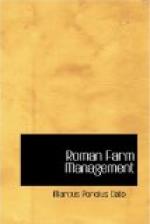wheat and woodland
tilth and vineyard, hive and horse and
herd,
but it does not appear that he ever followed the plough, or, what is more important, ever laid off a ploughgate. As a poet of nature no one was ever better equipped (the highest testimony is that of Tennyson), but when it came to writing poetry around the art of farm management it was necessary for him to turn to books for his facts. He acknowledges (Geo. I, 176) his obligation only to veterum praecepta without naming them, but as M. Gaston Boissier says he was evidently referring to Varro “le plus moderne de tous les anciens."[7] Virgil evidently regarded Varro’s treatise as a solid foundation for his poem and he used it freely, just as he drew on Hesiod for literary inspiration, on Lucretius for imaginative philosophy, and on Mago and Cato and the two Sasernas for local colour.
Virgil probably had also the advantage of personal contact with Varro during the seven years he was composing and polishing the Georgics. He spent them largely at Naples (Geo. IV, 563) and Varro was then established in retirement at Cumae: thus they were neighbours, and, although they belonged to different political parties, the young poet must have known and visited the old polymath; there was every reason for him to have taken advantage of the opportunity. Whatever justification there may be for this conjecture, the fact remains that Varro is in the background every where throughout the Georgics, as the “deadly parallel” in the appended note will indicate. This is perhaps the most interesting thing about Varro’s treatise: instructive and entertaining as it is to the farmer, in the large sense of the effect of literature on mankind, Virgil gave it wings—the useful cart horse became Pegasus.
As a consequence of the chorus of praise of the Georgics, there have been those, in all ages, who have sneered at Virgil’s farming. The first such advocatus diaboli was Seneca, who, writing to Lucilius (Ep. 86) from the farm house of Scipio Africanus, fell foul of the advice (Geo, I, 216) to plant both beans and millet in the spring, saying that he had just seen at the end of June beans gathered and millet sowed on the same day: from which he generalized that Virgil disregarded the truth to turn a graceful verse, and sought rather to delight his reader than to instruct the husbandman. This kind of cheap criticism does not increase our respect for Nero’s philosophic minister.[8] Whatever may have been Virgil’s mistakes, every farmer of sentiment should thank God that one of the greatest poems in any language contains as much as it does of a sound tradition of the practical side of his art, and here is where Varro is entitled to the appreciation which is always due the schoolmaster of a genius.




